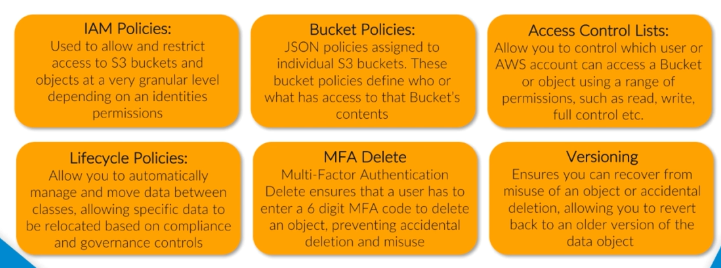¶ Protecting your data

Some of these security features, which can help you maintain a level of data protection are:
¶ IAM Policies
Can be used to both allow and restrict access to S3 buckets and objects at a very granular level depending on identities permissions.
¶ Bucket Policies
JSON policies assigned to individual buckets, whereas IAM Policies are permissions relating to an identity, a user group, or role. These Bucket Policies can also define who or what has access to that bucket's contents.
Can be used for Cross-Account Access.
¶ Access Control Lists
These allow you to control which user or AWS account can access a Bucket or object, using a range of permissions, such as read, write, or full control, et cetera.
¶ Lifecycle Policies
Lifecycle Policies allow you to automatically manage and move data between classes, allowing specific data to be relocated based on compliance and governance controls you might have in place.
¶ MFA Delete
Multi-Factor Authentication Delete ensures that a user has to enter a 6 digit MFA code to delete an object, which prevents accidental deletion due to human error.
¶ Versioning
Enabling versioning on an S3 bucket, ensures you can recover from misuse of an object or accidental deletion, and revert back to an older version of the same data object. The consideration with versioning is that it will require additional space as a separate object is created for each version, so that's something to bear in mind.
When possible, and if S3 is to be used as a backup solution, than there should be no reason to expose or configure these buckets as publicly accessible, and so you should enforce as many of these security mechanisms as possible, based on the risk factor of the data being stored.